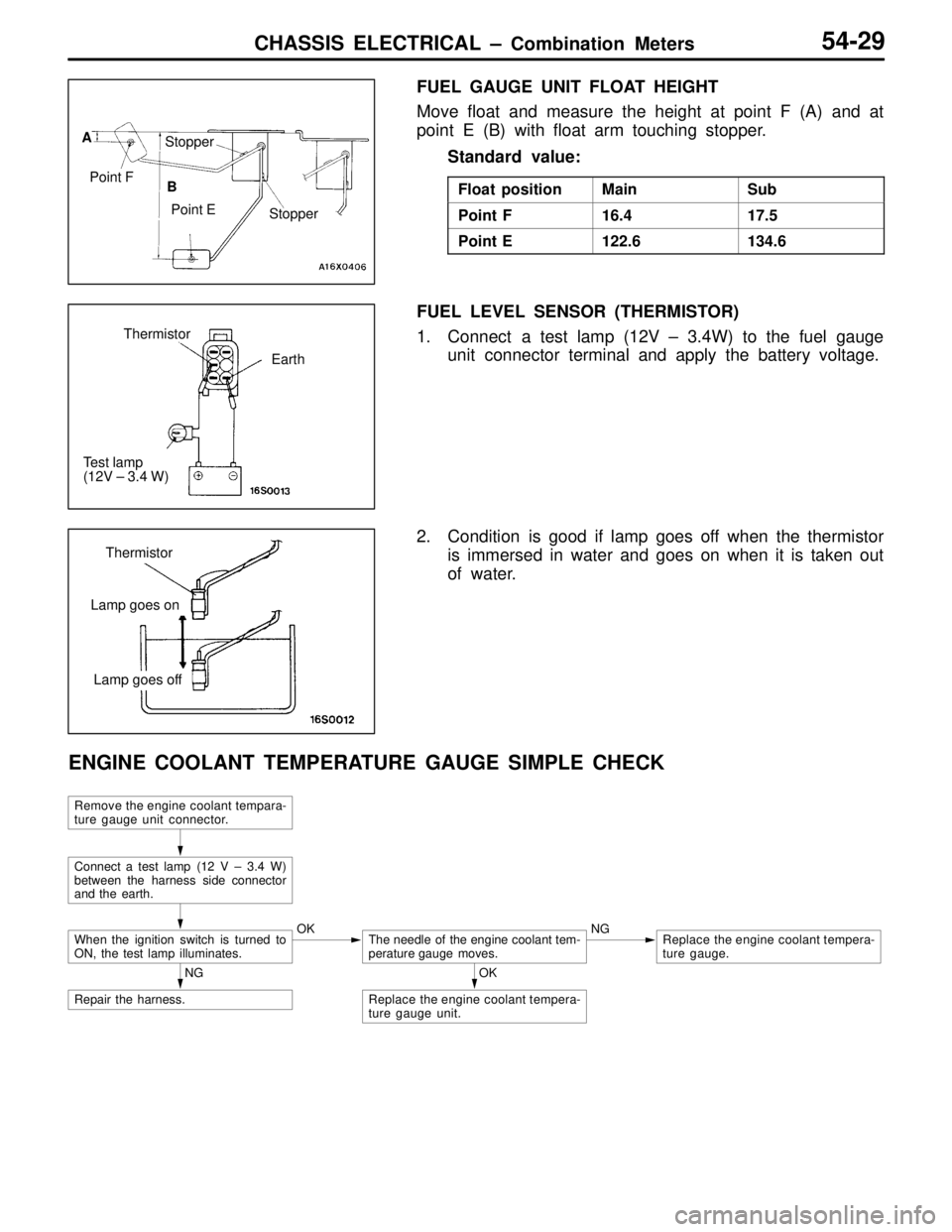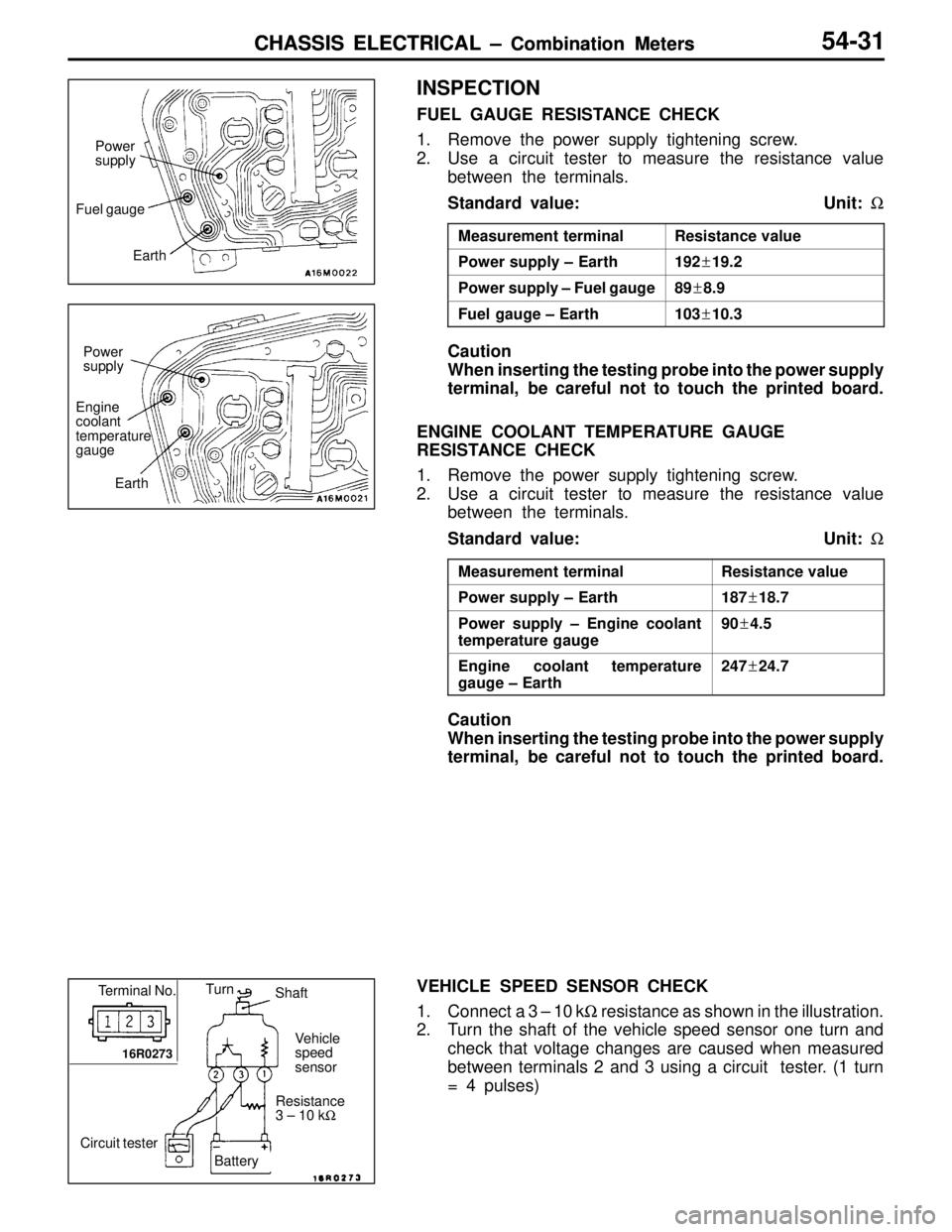Page 360 of 558

CHASSIS ELECTRICAL – Combination MetersCHASSIS ELECTRICAL – Combination Meters54-22
COMBINATION METERS
SERVICE SPECIFICATIONS
ItemsStandard valueLimit
SpeedometerAllowable indication range km/h
(Speedometer indication error to be
4037 – 45–
(Speedometer indication error to be
with –6% to +10%)8075 – 88–)
120113 – 132–
160150 – 176–
Pointer fluctuation km/h (at vehicle speeds of higher than 35
km/h)–±3
Tachometer indica-
tion error r/min
700All types of tachometer±100–
tion error r/min3,000Meters measurable up to 6,000 rpm and
meters measurable up to 8,000 rpm+ 150–
Meters measurable up to 9,000 rpm and
meters measurable up to 10,000 rpm+ 225
– 100–
4,750Meters measurable up to 6,000 rpm±160–
5,000Meters measurable up to 8,000 rpm±250–
Meters measurable up to 9,000 rpm and
meters measurable up to 10,000 rpm+ 325
– 125–
6,000Meters measurable up to 8,000 rpm±300–
7,000Meters measurable up to 9,000 rpm and
meters measurable up to 10,000 rpm+ 400
– 100–
8,000Meters measurable up to 10,000 rpm+ 400
– 0–
Fuel gauge unit
resistanceΩ
Main tankFloat point F1.8 ±1.2–
resistance ΩFloat point E65.2 ±4–
Sub tankFloat point F1.2 ±0.8–
Float point E44.8 ±3–
Fuel gauge unit
f
loat height mm
Main tankFloat point F16.4–
float height mmFloat point E122.6–
Sub tankFloat point F17.5–
Float point E134.6–
Engine coolant temperature gauge unit resistance (at 70 �C) Ω104 ±13.5–
Fuel gauge resis-
tanceΩ
Power supply and earth192 ±19.2–
tance ΩPower supply and fuel gauge89 ±8.9–
Fuel gauge and earth103 ±10.3–
Engine coolant
temperature gauge
Power supply and earth187 ±18.7–
temperature gauge
resistance ΩPower supply and engine coolant temperature gauge90 ±4.5–
Engine coolant temperature gauge and earth247 ±24.7–
Page 361 of 558
CHASSIS ELECTRICAL – Combination Meters54-23
SEALANT
ItemsSpecified sealantRemark
Engine coolant temperature gauge
unit threaded portion3M Adhesive nut locking No. 4171 or
equivalentDrying sealant
SPECIAL TOOLS
ToolNumberNameUse
A
B
C
D
MB991223
A: MB991219
B: MB991220
C: MB991221
D: MB991222Harness set
A: Test harness
B: LED harness
C: LED harness
adapter
D: ProbeFuel gauge simple check
A: Connector pin contact pressure check
B, C: Power circuit check
D: Commercial tester connection
Page 367 of 558

CHASSIS ELECTRICAL – Combination Meters54-29
FUEL GAUGE UNIT FLOAT HEIGHT
Move float and measure the height at point F (A) and at
point E (B) with float arm touching stopper.
Standard value:
Float positionMainSub
Point F16.417.5
Point E122.6134.6
FUEL LEVEL SENSOR (THERMISTOR)
1. Connect a test lamp (12V – 3.4W) to the fuel gauge
unit connector terminal and apply the battery voltage.
2. Condition is good if lamp goes off when the thermistor
is immersed in water and goes on when it is taken out
of water.
ENGINE COOLANT TEMPERATURE GAUGE SIMPLE CHECK
Remove the engine coolant tempara-
ture gauge unit connector.
Connect a test lamp (12 V – 3.4 W)
between the harness side connector
and the earth.
When the ignition switch is turned to
ON, the test lamp illuminates.OKThe needle of the engine coolant tem-
perature gauge moves.NGReplace the engine coolant tempera-
ture gauge.
OK
Replace the engine coolant tempera-
ture gauge unit.
NG
Repair the harness.
Point F
Point E
A
B Stopper
Stopper
Test lamp
(12V – 3.4 W)
Earth
Thermistor
Thermistor
Lamp goes on
Lamp goes off
Page 368 of 558
CHASSIS ELECTRICAL – Combination Meters54-30
ENGINE COOLANT TEMPERATURE GAUGE UNIT
CHECK
1. Bleed the engine coolant.
2. Remove the engine coolant temperature gauge unit.
3. Immerse the unit in 70�C water to measure the resistance.
Standard value: 104 ±13.5 Ω
4. After checking, apply the specified adhesive around the
thread of engine coolant temperature gauge unit. Then,
tighten the unit to the specified torque.
Specified sealant:
3M Adhesive Nut Locking No. 4171 or equivalent
5. Add engine coolant.
COMBINATION METERS
REMOVAL AND INSTALLATION
2 1
3
Vehicle speed sensor removal
steps
�Battery and battery tray
�Air cleaner assembly
1. Vehicle speed sensorCombination meter removal steps
2. Meter bezel
3. Combination meter
ThermometerCircuit tester
10 – 12 Nm
Page 369 of 558

CHASSIS ELECTRICAL – Combination MetersCHASSIS ELECTRICAL – Combination MetersCHASSIS ELECTRICAL – Combination Meters54-31
INSPECTION
FUEL GAUGE RESISTANCE CHECK
1. Remove the power supply tightening screw.
2. Use a circuit tester to measure the resistance value
between the terminals.
Standard value: Unit: Ω
Measurement terminalResistance value
Power supply – Earth192±19.2
Power supply – Fuel gauge89±8.9
Fuel gauge – Earth103±10.3
Caution
When inserting the testing probe into the power supply
terminal, be careful not to touch the printed board.
ENGINE COOLANT TEMPERATURE GAUGE
RESISTANCE CHECK
1. Remove the power supply tightening screw.
2. Use a circuit tester to measure the resistance value
between the terminals.
Standard value: Unit: Ω
Measurement terminalResistance value
Power supply – Earth187±18.7
Power supply – Engine coolant
temperature gauge90±4.5
Engine coolant temperature
gauge – Earth247±24.7
Caution
When inserting the testing probe into the power supply
terminal, be careful not to touch the printed board.
VEHICLE SPEED SENSOR CHECK
1. Connect a 3 – 10 kΩ resistance as shown in the illustration.
2. Turn the shaft of the vehicle speed sensor one turn and
check that voltage changes are caused when measured
between terminals 2 and 3 using a circuit tester. (1 turn
= 4 pulses)
Fuel gauge
Power
supply
Earth
Earth
Power
supply
Engine
coolant
temperature
gauge
TurnShaft
Circuit testerResistance
3 – 10 kΩ Vehicle
speed
sensor Terminal No.
16R0273
Battery
Page 408 of 558
– Heater Unit and Blower Unit HEATER AND MANUAL
AIR CONDITIONER55-18
HEATER UNIT AND BLOWER UNIT
REMOVAL AND INSTALLATION
Pre-removal and Post-installation Operation
�Engine Coolant Draining and Refilling
�Air Cleaner Cover and Hose Removal and
Installation
�Floor Console and Instrument Panel Removal and
Installation
�Rear Seat Heater Duct Removal and Installation
(Refer to P.55-31.)
1
34
5
6
2 7 8
9 1011
Removal steps
1. Center reinforcement RH
2. Heater control assembly
3. Center reinforcement LH
4. Center ventilation duct
5. Foot distribution duct
6. Joint duct7. Blower unit
8. Heater hose
9. Heater unit
10. Heater core support
11. Heater core
Page 409 of 558

– Heater Unit, Cooling and Blower Unit HEATER AND MANUAL
AIR CONDITIONER55-19
HEATER UNIT, COOLING AND BLOWER UNIT
REMOVAL AND INSTALLATION
Pre-removal and Post-installation Operation
�Engine Coolant Draining and Refilling
�Discharging and Charging of Refrigerant
(Refer to P.55-6.)
�Air Cleaner Cover and Hose Removal and
Installation
�Floor Console and Instrument Panel Removal and
Installation
�Rear Seat Heater Duct Removal and Installation
(Refer to P.55-31.)
1
34
5 6
2 7
8 9
10 1112
Piping connection
O-ring
A/C Compressor oil: SUN PAG 56
Removal steps
1. Center reinforcement RH
2. Heater control assembly
3. Center reinforcement LH
4. Center ventilation duct
5. Foot distribution duct
6. Drain hose
�A�7. Connection between cooling unit
and refrigerant line8. Cooling and blower unit
9. Heater hose
10. Heater unit
11. Heater core support
12. Heater core
REMOVAL SERVICE POINT
�A�REMOVAL OF REFRIGERANT LINE FROM
COOLING UNIT
Plug the open end of the removed hose and the opening
in the cooling unit to prevent entry of dust and foreign
substances.
Caution
Compressor oil and the receiver are highly
moisture-absorptive.
Do not use plugs allowing ventilation.
Page 459 of 558
– Engine Compartment WIRING HARNESS
CONFIGURATION DIAGRAMSC-5
A-29 (2-B) Front harness and battery harness
combination
A-33 (1) Horn (LH)
A-34 (1) Horn (LH)
A-35 (2-BR) Outside air temperature sensor
with fully automatic air conditioner>
A-38 (2-B) Engine coolant temperature sensorA-39 (1-B) Engine coolant temperature gauge unit
A-45 (1) Horn (RH)
A-46 (1) Horn (RH)
A-49 (2-BR) Dual pressure switch
A-50 (2-B) Front speed sensor (RH)
ABS>